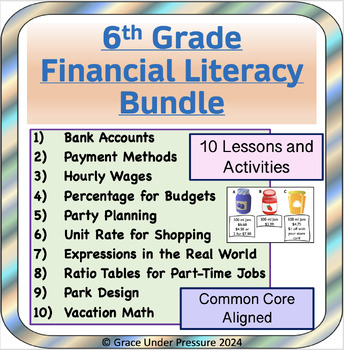6th Grade Financial Literacy Bundle: 10 Activities: Budgeting, Ratios, Decimals
- Zip
- Easel Activity
Products in this Bundle (9)
showing 1-5 of 9 products
Bonus
Description
Are you looking to incorporate more financial literacy and budgeting into your 6th Grade Math class? Do you want to show your students how the math they learn in class (from geometry to statistics to expressions to ratios) can be applied in real world, useful situations?
This is the bundle for you!
These 10 lessons and activities are aligned to 6th Grade Common Core Standards and include clear instructions, fun visuals, and engaging, real-life math tasks for your students to tackle.
1) Bank Account Board Game: Your students will practice loads of mental math as they keep a running tally of their bank account balance.
2) How to Pay: This 8-page booklet teaches students all about cash, credit cards, debit cards and more (and includes practice math questions too).
3) Hourly Wages: Apply 6th grade statistics skills such as mean, median and interquartile range to explore the variation in hourly wages and discover what a positive skew is.
4) Birthday Party Budget: Use percentages to break a budget up into specific categories when planning for a birthday party.
5) 4th of July or Canada Day Word Problems: Use factors, multiples, and unit rates to plan a summer party and all the supplies you would need to buy.
6) Grocery Shopping: Price Comparisons: Practice finding the best deal at the grocery store using decimals and unit rates.
7) Equivalent Expressions: Practice writing equivalent expressions for real-world financial situations using skills such as the distributive property and adding and subtracting integers.
8) Ratio Tables: Saving Up with a Part-Time Job: Work with ratio tables and graphs to practice saving up for a big purchase by using wages from a part-time job.
9) Park Design Project: Use geometry skills (area, perimeter, volume) to plan and design a park. Then, calculate the cost using decimal operations.
10) FREEBIE: Vacation Math: Use a variety of math skills to plan a vacation.
All activities are PDFs: ready to print and go. Complete Answer Keys are included!





